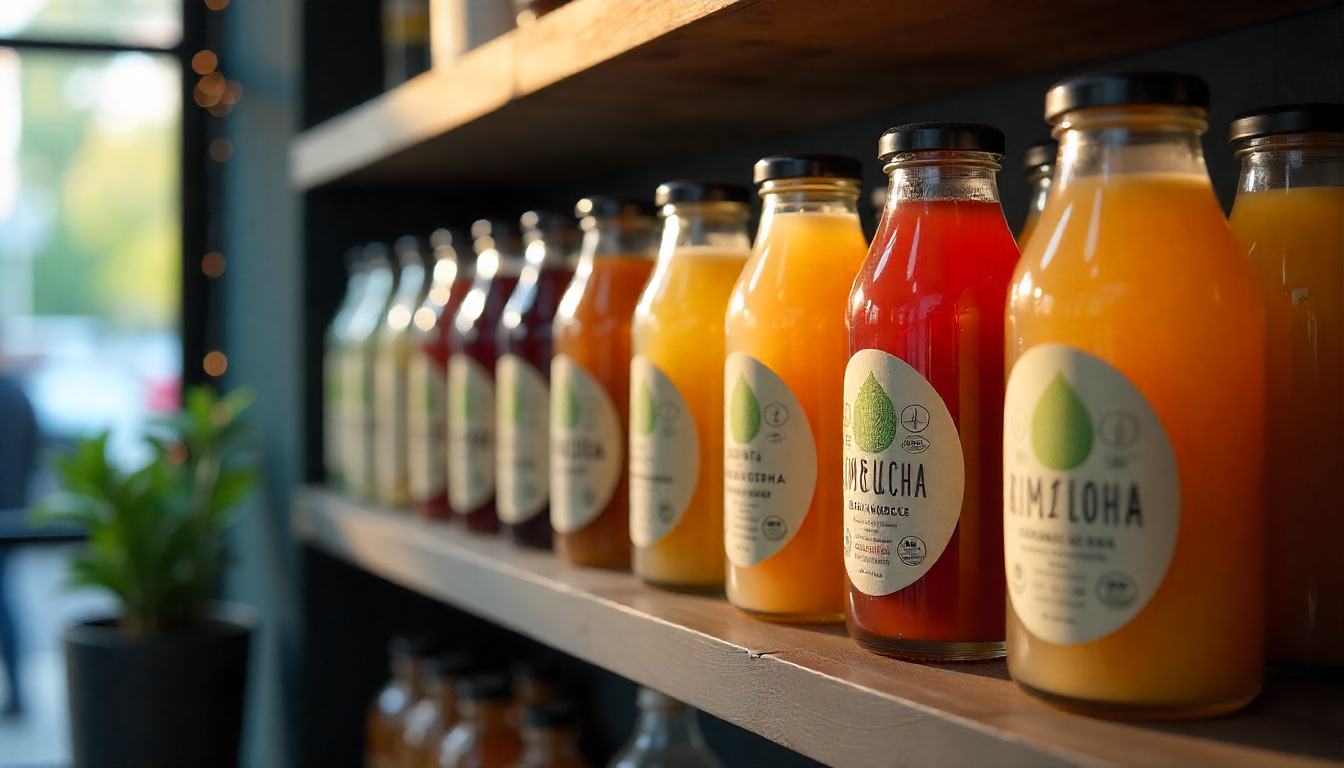If you’d told my younger self that someday I’d be brewing weird-smelling tea in glass jars covered with cloth — I’d have laughed in your face. Fast forward to today: my fridge is lined with swing-top bottles of fizzy, tart, slightly sweet homemade kombucha. And you know what? I wouldn’t trade it for the world.
But as kombucha takes over supermarket shelves — from neon-colored cans to fancy glass bottles with lotus flowers on the label — it’s fair to ask: Is kombucha really as magical as everyone claims? Or is it just another overhyped wellness trend with hidden sugar bombs inside?
Let’s get honest about it — and I’ll share how you can enjoy kombucha right, plus my go-to kombucha recipe so you can skip the overpriced bottles and brew your own.
Table of Contents
How I Fell in Love (and Occasionally Out of Love) With Kombucha
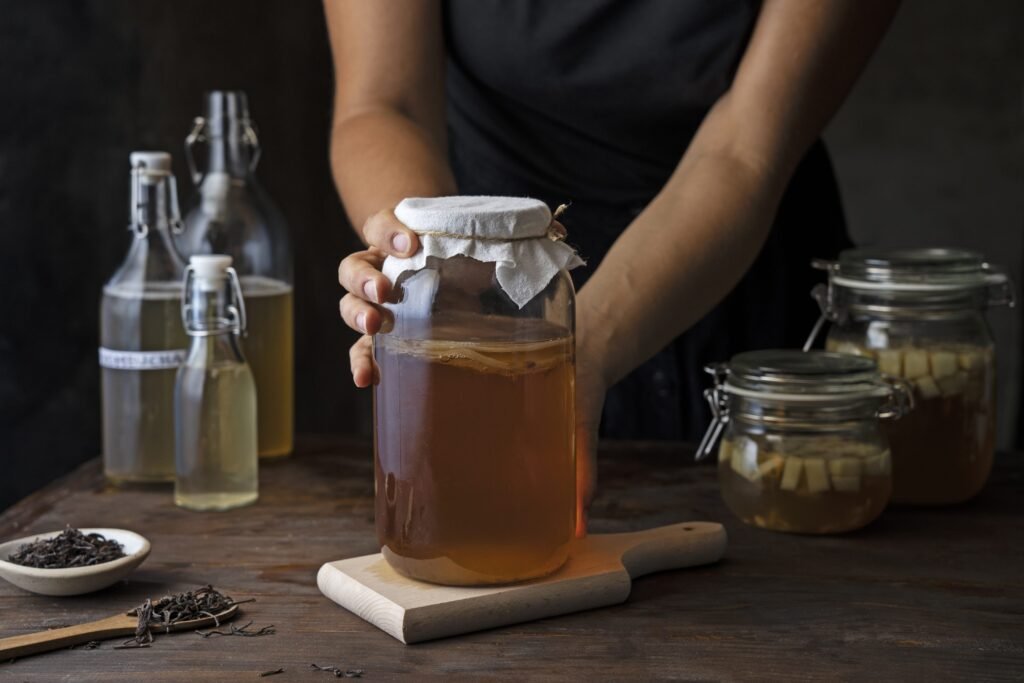
Years ago, I was a die-hard soda drinker. Coke with lunch, Dr. Pepper as a pick-me-up, the occasional root beer float on weekends. My gut? A mess. My skin? A battlefield. My energy? Non-existent by 3 PM.
Then I discovered kombucha at a tiny health food store. The cashier told me, “This’ll help your tummy.” I cracked open the bottle in the car — it was tangy, bubbly, slightly sweet. Weird, but oddly refreshing.
One bottle turned into a daily habit. And at first, it felt like magic. My bloating calmed down. My soda cravings shrank. I felt cleaner, somehow. I wanted to know everything: Does kombucha have caffeine? What’s this SCOBY thing? How do you make kombucha at home?
Years later, after brewing countless gallons, experimenting with every kombucha recipe under the sun, and spending more than I care to admit on fancy bottles, here’s my honest verdict:
Kombucha can be amazing for you — but there’s sugar fine print that no one talks about.
So, What Is Kombucha, Really?
At its simplest, kombucha is just fermented tea. You brew tea, add sugar, cool it, and pour in a SCOBY — that’s the Symbiotic Culture Of Bacteria and Yeast. The SCOBY eats the sugar and produces good acids, a little alcohol, carbon dioxide (bubbles!), and probiotics.
The result: a tangy, fizzy drink packed with live cultures.
When you see kombucha recipe or how to make kombucha guides online, they all share the same basics:
- Brew tea (black or green tea is typical — which means yes, kombucha does have caffeine, though usually much less than coffee).
- Add sugar (which feeds the SCOBY).
- Ferment for about 7–14 days.
- Bottle it for a few days more to build up fizz (the fun part).
But here’s the twist: the sugar. Let’s talk about that.
Kombucha vs. Soda: A Real Comparison
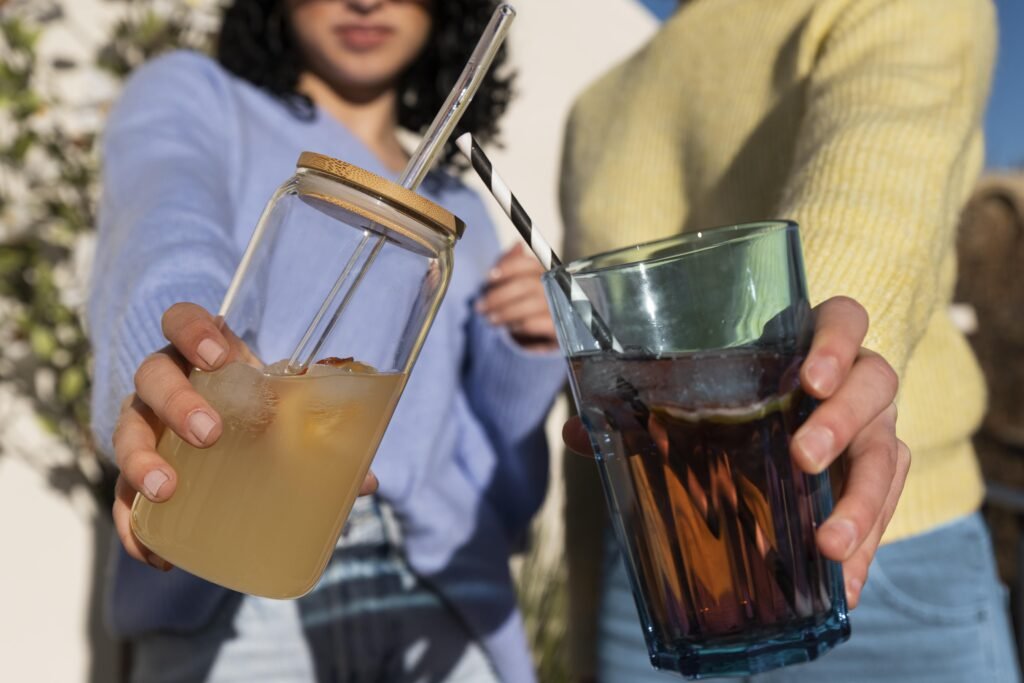
Let’s be real. Even sweet kombucha is usually better than a can of Coke. A standard soda packs 39 grams of sugar in 12 ounces — mostly high fructose corn syrup. Kombucha, at its sweetest, is maybe half that — and with the benefit of organic acids and live probiotics.
Plus, kombucha naturally contains:
- Glucuronic acid (may help detox)
- Lactic acid bacteria
- Antioxidants (from the tea)
- Organic acids that may support digestion
So if you’re swapping soda for kombucha, you’re still ahead. But if you’re chugging two or three bottles daily, you might be taking in an extra 30–40 grams of sugar a day. That adds up.
Does Kombucha Have Caffeine? A Realistic Look
People ask me this all the time. Kombucha starts with black or green tea, so yes — it does have caffeine. But the fermentation process breaks some of it down.
On average:
- 8 oz cup of black tea: ~40–70 mg caffeine
- 8 oz cup of coffee: ~90–120 mg caffeine
- 8 oz glass of kombucha: ~10–25 mg caffeine
So if you’re sensitive to caffeine, don’t drink a bottle of booch right before bed — but compared to your morning coffee, it’s mild. If you want caffeine-free kombucha, you can brew with rooibos tea instead — a popular trick for nighttime sippers.
Does Kombucha Have Alcohol? Here’s the Truth
Fermentation naturally makes a little alcohol — usually around 0.5% ABV, about the same as overripe fruit. Most people won’t feel a thing.
But: Some craft kombucha brands push the fermentation further to make hard kombucha, with 3%–7% alcohol — basically a light beer. Popular at health-conscious happy hours!
If you’re pregnant, breastfeeding, or avoiding alcohol, stick to trusted brands or brew your own with short ferments.
How to Make Kombucha at Home (My Go-To Kombucha Recipe)
Once you learn how to make kombucha, you’ll never look at store-bought the same way. You control the flavor, the fizz, the sugar — and you save so much money.
Here’s my tried-and-true kombucha recipe:
✨ Basic Kombucha Recipe
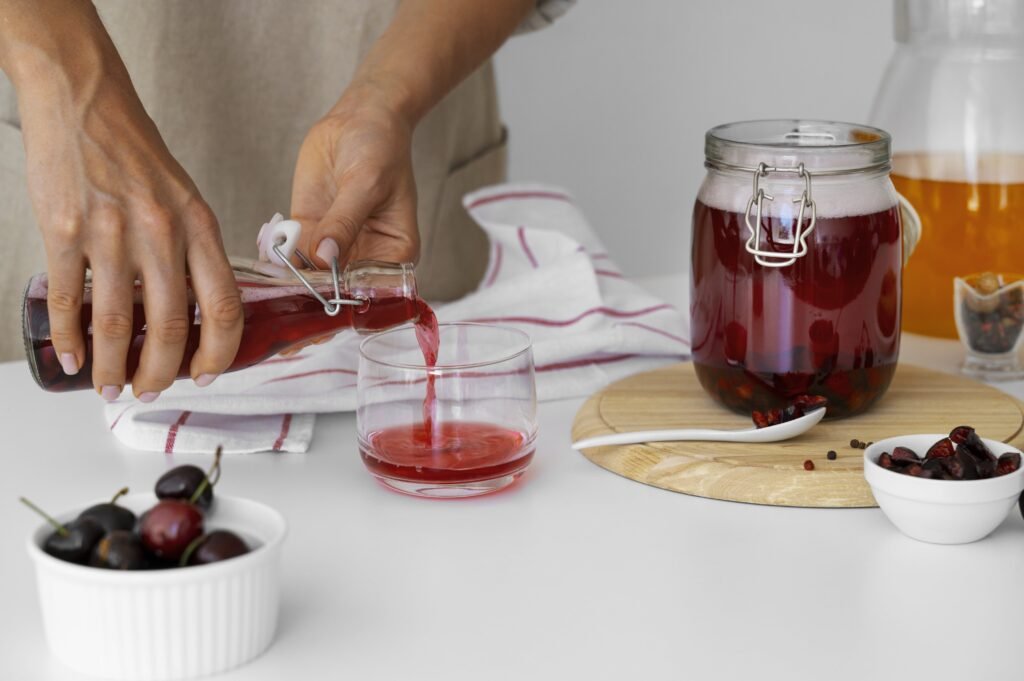
Ingredients:
- 8 cups water
- 4–6 bags black or green tea
- 1 cup organic cane sugar
- 1 SCOBY + 1–2 cups starter tea (from a previous batch or store-bought raw kombucha)
Steps:
1️⃣ Boil the water, steep the tea for 10 minutes.
2️⃣ Stir in the sugar while the tea is hot — let it fully dissolve.
3️⃣ Let the sweet tea cool to room temp (heat can kill your SCOBY).
4️⃣ Pour into a large glass jar, add the SCOBY and starter tea.
5️⃣ Cover with a breathable cloth or coffee filter.
6️⃣ Ferment at room temp for 7–10 days. Taste daily starting day 7.
7️⃣ Once it’s tangy to your liking, bottle it, leaving an inch of headspace.
8️⃣ Optional: Add flavorings (ginger, berries, herbs). Seal and leave at room temp 2–5 days for carbonation.
9️⃣ Refrigerate and enjoy!
Tip: Always keep your equipment clean — kombucha is alive, and you don’t want bad bacteria sneaking in.
Flavor Ideas to Keep It Fun
- Ginger + lemon
- Strawberry + basil
- Pineapple + mint
- Blueberry + lavender
This is my favorite part — getting creative. Once you know how to make kombucha, it’s endless fun. Plus, you’ll notice your homemade brew is far less sugary than many store brands.
Sustainable Brewing: Save Money & Cut Waste
When I first priced my store-bought kombucha habit, I almost fell over. $4 per bottle × 5 a week = $80/month. Brewing at home? A SCOBY, tea, and sugar cost pennies per batch.
Plus:
Keep a SCOBY hotel to share with friends. Kombucha brings people together!
Reuse glass bottles.
Use old SCOBYs for compost, pet treats, or garden fertilizer.
Is Kombucha Good for Your Gut?
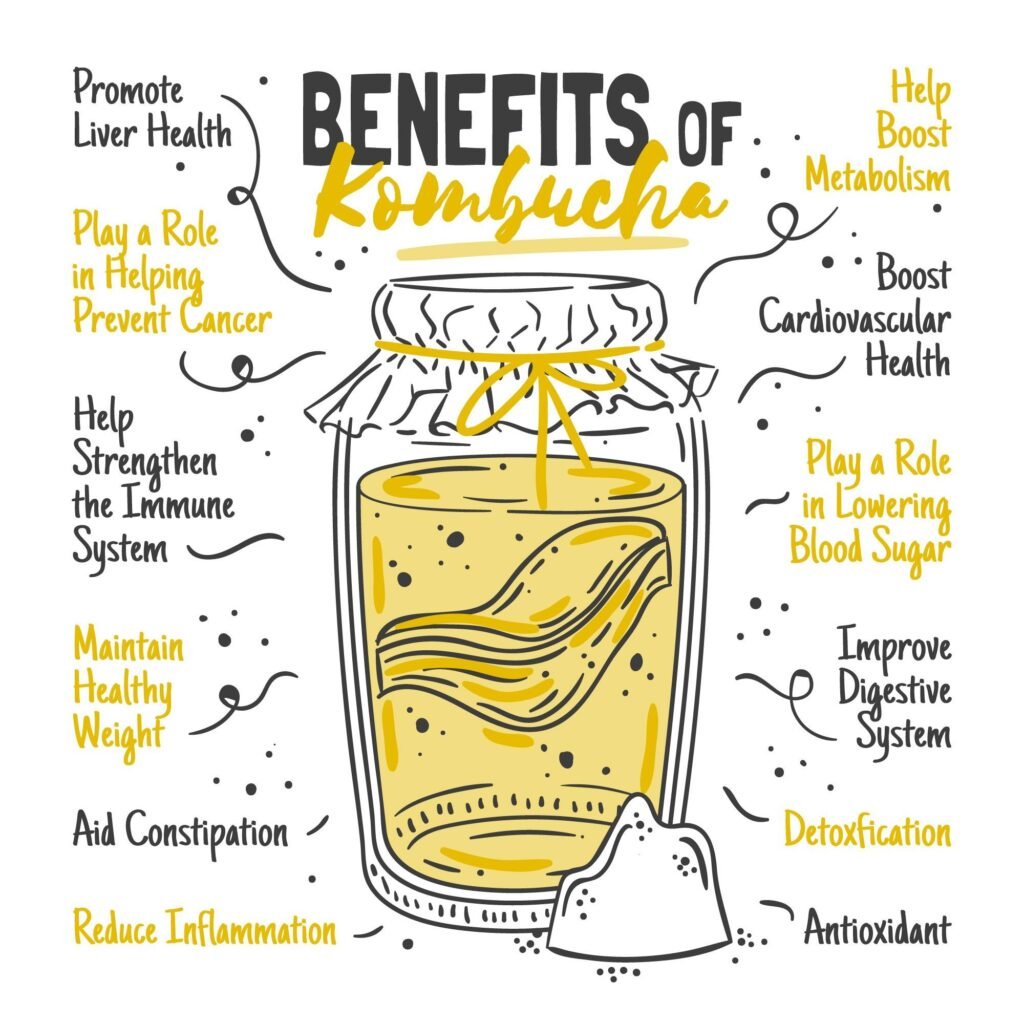
Let’s touch on the gut health hype. Many people swear kombucha helps with digestion, bloating, or general gut balance.
Here’s what science says:
- Fermented foods can introduce beneficial bacteria.
- Raw kombucha does contain live cultures.
- The acids may support gut barrier function.
But don’t expect kombucha alone to fix your gut. It’s just one piece of the puzzle — along with fiber, stress management, sleep, and diverse whole foods. For me, kombucha replaced soda and kept me hydrated with something fun and fizzy. That alone made it worthwhile.
The Kombucha Trap: Store-Bought vs. Homemade
Let’s break it down:
| Store-Bought | Homemade | |
|---|---|---|
| Cost | $3–5 per bottle | Pennies per glass |
| Sugar | Varies wildly | You control it |
| Flavor | Consistent | Fully customizable |
| Caffeine | Mild | Depends on tea used |
| Fizz | Always bubbly | Sometimes takes practice |
| Probiotics | May vary | Fresh, living cultures |
Hidden Ingredients: What to Watch for in Store-Bought Kombucha
If you’re reaching for that pretty glass bottle at your grocery store, pause for a second — flip it around and really read that label. Not all kombucha is created equal.
Here’s what to watch for:
- Extra sugar: Some brands add extra fruit juices or syrups after fermentation. Tasty, but sneaky sugar bomb.
- ‘Natural flavors’: Can mean anything from fruit puree to mystery additives.
- Pasteurization: Some mass-market kombucha is pasteurized to extend shelf life, but that kills the live cultures — the main reason you’re drinking it!
- Added probiotics: If they’re adding powdered cultures to make up for pasteurization, you’re not getting the same fermentation benefit.
Quick tip: Look for labels that say raw, unpasteurized, and check sugar grams — aim for under 8g per serving if you’re mindful.
How Much Kombucha Should You Drink?
A healthy adult can usually handle a glass or two daily. Too much can cause bloating or digestive upset — it’s acidic and may have trace alcohol (under 0.5% if done right).
When I first learned how to make kombucha, I drank a full bottle every day. But I quickly realized my gut felt better with a smaller glass — about 4–8 ounces — and switching flavors to keep things interesting
Who Should Avoid Kombucha?
- Pregnant or nursing? Talk to your doc — it’s raw, lightly alcoholic.
- Sensitive stomach? Start slow.
- Histamine issues? Some people react to fermented foods.
- Immune-compromised? Home brewing must be done carefully to avoid contamination.
My Final Verdict: Kombucha — Overrated or Underrated?
Here’s the thing: kombucha is neither miracle nor menace. It’s not going to magically heal your gut overnight — but it is a fun, fizzy, functional alternative to soda, energy drinks, or sugary juices.
When brewed well — with an eye on sugar — kombucha is underrated in how it can:
Help you ditch soda
Satisfy a craving for bubbles
Offer a gentle dose of probiotics
Keep your taste buds excited
But if you think guzzling three sweet bottles a day will cure bloating and transform your microbiome while ignoring fiber, stress, or sleep — that’s the overrated part
Ready to Brew? Let’s Do This
If you’ve read this far — you’re clearly curious. So here’s your sign: pick up a SCOBY, grab some tea, and try your first batch.
There’s something special about seeing that bubbly jar on your counter. About popping open a homemade bottle and hearing the satisfying pssst. About knowing exactly what’s in your glass.
And if you do — come back and tell me your kombucha recipe tweaks, your wildest flavor combos, or the answer to: does kombucha have caffeine? Yes — but with your own brew, you get to decide how much.
Let’s Raise a Glass
Kombucha may be trendy. But for me, it’s become something simple: a reminder that small, fizzy rituals can change how you feel — one sip at a time.
Now, go brew some magic.
✨ Have a favorite kombucha flavor or brewing tip? Drop it in the comments below — I love swapping recipes with fellow booch fans!
Trending Kombucha FAQs: What People Really Ask
1. Can I drink kombucha every day?
Yes — most people can safely enjoy a glass of kombucha daily. Start with a small serving (4 to 8 ounces) and see how your body reacts. Too much at once can cause bloating or mild digestive upset, especially if your gut isn’t used to fermented foods yet.
2. Is kombucha good for weight loss?
Kombucha is not a magic weight loss drink, but swapping it for soda or sugary juices can help you cut excess calories and added sugar. It may also support gut health, which can indirectly help with metabolism and healthy digestion.
3. Does kombucha help with bloating?
Some people find kombucha’s probiotics and organic acids help ease bloating and aid digestion. For others, the carbonation or acids can cause more bloating, especially in large amounts. Start slow and listen to your body.
4. Can kombucha make you drunk?
Regular store-bought kombucha contains trace amounts of alcohol (generally under 0.5% ABV). You would have to drink an unrealistic amount to feel any buzz. However, “hard kombucha” is brewed with extra alcohol and can contain 3% to 7% ABV, so always check the label.
5. Is kombucha safe during pregnancy?
Kombucha is raw, naturally fermented, and slightly alcoholic. Many doctors recommend pregnant or breastfeeding people avoid unpasteurized drinks. If you are pregnant, check with your healthcare provider before drinking kombucha.
6. Does kombucha have caffeine?
Yes — kombucha is made with black, green, or oolong tea, so it naturally contains caffeine. The final brew usually has about 10% to 25% of the original tea’s caffeine content. If you want to lower it, brew with decaffeinated tea or herbal options like rooibos.
7. How much sugar is in kombucha?
The sugar content depends on how long you ferment it and the brand. Homemade kombucha can have 2 to 6 grams of sugar per 8-ounce serving if fully fermented. Many store-bought kombuchas contain extra fruit juices or sweeteners, pushing sugar up to 15 grams or more per bottle. Always read the nutrition label.
8. How do you make kombucha at home?
The basic steps are simple: brew sweet tea, let it cool, add your SCOBY and starter tea, cover, and let it ferment at room temperature for 7 to 14 days. Taste it to find your preferred balance of sweetness and tang. Then bottle it with flavorings (like ginger or berries) and let it ferment for a few more days to build fizz. For full details, check my complete kombucha recipe guide.
9. How long does kombucha take to ferment?
Typically, the first fermentation lasts 7 to 14 days, depending on room temperature and your taste preference. Warmer temps speed up fermentation. A longer ferment means less sugar and a tangier taste. The second fermentation for carbonation usually takes 2 to 5 days.
10. What is a SCOBY and why is it important?
SCOBY stands for “Symbiotic Culture Of Bacteria and Yeast.” It’s a living culture that ferments the sweet tea into kombucha by consuming sugar and producing beneficial acids, probiotics, and carbonation. Without a healthy SCOBY, you can’t make proper kombucha.
